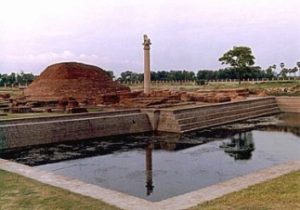Patna, Bihar: The Kolhua archaeological site in Muzaffarpur district joins 27 other archeological sites across the country that will be developed with “world class facilities” for tourists by next year.
“Twenty-seven sites have been selected at the national level and directions given to develop them with world-class facilities within a year,” Patna circle superintending archaeologist D.N. Sinha said. “Kolhua is the only place from Bihar on the list. It is an important site for us and also on the tentative list of Unesco world heritage sites.”
Located around 65km northwest of Patna, Kolhua has an Asokan pillar, an ancient Buddhist stupa, a water tank, an abode where Lord Buddha spent several rainy seasons and two monasteries.
The Archaeological Survey of India (ASI), had carried out excavations at the site. Findings suggest the place was inhabited from the 7th century BC to the 7th century AD.
Development plans have already been chalked out.
Patna circle superintending archaeologist D.N. Sinha said several steps will be taken to develop the place keeping in mind its historicity and value, and tourists from different countries who flock there.
“On an average 1,000 tourists visit Kolhua daily, so we have proposed to acquire two acres near the site to provide them direct access from the main road,” Sinha said. “Better restroom facilities, ample parking space, quality signage, benches, garbage management, painting the outer boundary and installing iron grilles around it are our plans.”
The place is also associated with the legend in which the monkey king offered a bowl of honey to Lord Buddha, considered one of the eight most significant events of his life. Buddhist texts suggest, he (Buddha) made a prophesy of his own mahaparinirvana (liberation) and its date to his disciples while staying at Kolhua.
Kolhua’s popularity is on the ascendant as it lies on the route taken by Buddhist pilgrims who visit Bodh Gaya, Nalanda and Rajgir and then Kushinagar, where Buddha attained nirvana.
The ASI is also going to redesign the entrance to make it aesthetically compatible with the ancient structure. An interpretation centre having a 60-seat audio-visual hall and a cafeteria will be built; while a permanent exhibition gallery to provide information to visitors will also be established. “We will put up wooden railings around the ancient structures and also a water tank (which, according to Buddhist myth, was dug by monkeys). This will not only protect the monuments, but also provide safety to the visitors,” Sinha said.
The ASI also plans to clean out the outlet channel of the ancient tank, which was designed to check it from overflowing.
Security devices including metal detectors and CCTV cameras will be installed at the site.Towards the west of the tank, remains of a swastika-shaped monastery with 12 cells have been found. It has been identified as a nunnery , because remains of a toilet where unearthed outside, attached to the south-east corner of the monastery.
On the southern side of the tank another monastery has been unearthed. This has been identified as Kutagarshala on the basis of Chinese literature. This was the place where the Buddha was said to have stayed during the rainy seasons.



It is good to know that our Bihar is getting famous day by day.. as it is becoming tourist place
There’s so much in this state, be it food, culture, festivals, or anything, there’s so much to explore here. It feels great to see that people are finally recognizing Bihar.